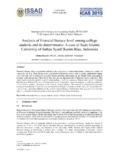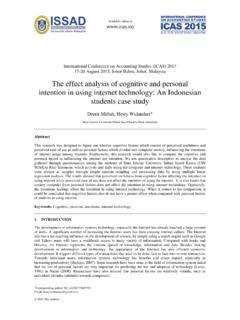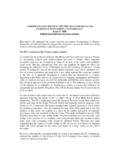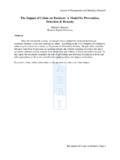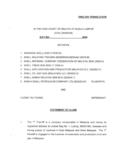Transcription of The types, costs, prevention and detection of …
1 Available online at _____ *Corresponding author. Tel.: +60-146-494392 E-mail: 2015 The Authors International Conference on Accounting Studies (ICAS) 2015 17-20 August 2015, Johor Bahru, Johor, Malaysia The types, costs, prevention and detection of occupational fraud: The ACFE perspective Ibrahim Umar*a, Rose Shamsiah Samsudinb, Mudzamir Mohamedb aDepartment of Accountancy, Yobe State University, Nigeria bSchool of Accountancy, UUM College of Business, Universiti Utara Malaysia Abstract Occupational fraud and abuse are an enormous problem, imposing adverse effects and practically affecting every organization and all sectors of the economy. The estimated global cost of fraud according to ACFE accounted for $ , $ and $ trillion in 2010, 2012 and 2014 respectively.
2 Three types of schemes have been identified by the Association of Certified Fraud Examiners (ACFE) in their various reports to the nation. The aim of this review is to depict the type, cost, and fraud control mechanisms. Occupational fraud schemes are very hard to detected. However, they are more likely to be detected by a tip than internal audits, internal controls or external audits. Thus, prevention of occupation fraud is better achieved through the use of hotlines, whistleblowing, effective internal control system and the use of forensic accounting in fraud detection is recommended for further studies. Keywords: Occupational fraud, asset misappropriation, corruption, fraudulent statements 1. INTRODUCTION Incidences of fraud globally have attracted the attention of professionals, policy makers, and the academic communities.
3 The growth in concern over occupational fraud has been attributed to the magnitude, schemes and the perpetrators of these acts. The world known cases of financial and corporate scandals of WorldCom, Waste Management, Enron, American Insurance Group and Lehman Brothers depict the distasteful nature of this form of fraud. For instance, the corporate scandals of WorldCom, Enron, and Lehman Brother accounted for $180 million, $74 million and $50 million respectively. At a global scene, the Association of Certified Fraud Examiners (ACFE) has estimated that occupational fraud and abuses caused a loss in revenue of about $ trillion in 2014. According to ACFE (2014) reports to the nation, frauds are carried out through assets misappropriation, corruption, and financial statement frauds.
4 Accordingly, Cressey (1950) observed that these acts are committed by individuals who have non-sharable financial pressures, having the opportunity to violate trust and able to rationalize their acts. These collectively form what is now known as the Fraud Triangle (Dorminey, Scott Fleming, Kranacher, & Riley, 2012). Studies have suggested the use of multiple methods of investigating, detecting and preventing financial fraud by examining the Fraud Triangle (Prabowo, 2013; Tommie, Aaron, Jack, & Robert, 2006). In addition, Albrecht, Albrecht, Albrecht, and Zimbelman (2012) and Lee and Fargher (2013) posit that auditing, management review, Proceedings of the International Conference on Accounting Studies (ICAS) 2015 17-20 August 2015, Johor Bahru, Johor, Malaysia 502 and whistleblowing are some of the effective tools used in fraud detection and prevention .
5 This is consistent with the findings of ACFE (2012). However, despites the number of fraud detection and prevention techniques, incidence of occupational fraud and abuses have been on the increase. Thus, requiring an understanding as to why frauds are on the increase. Therefore, this study intends to review the literature on types, costs and methods of fraud prevention and detection . 2. THE CONCEPT OF OCCUPATIONAL FRAUD Traditional accounting fraud is the intentional misrepresentation of financial statements in order to obtain an advantage wrongfully, retain a benefit, or avoid a detriment (Soltani, 2014 p259). While, ACFE (1996) defined occupational fraud as the use of one's occupation for personal enrichment through the deliberate misuse or misapplication of the employing organization's resources or assets.
6 The Association classified this act into asset misappropriation, corruption, and fraudulent financial statement. In addition, the reports try to identify the cost, victims, and perpetrators. The ways in which employees misuse organization s resources for personal economic benefits has been studied by researchers and professional bodies (ACFE, 2014; Holtfreter & Holtfreter, 2004; Mike, 2012). They come in different schemes including the Ponzi Scheme, assets misappropriation and corruption (Albrecht et al., 2012; Dellaportas, 2013; Efiong, 2012; Rezaee, 2005; Rothlin & Haghirin, 2013). Accordingly, ACFE (2014) and PriceWaterhouseCoopers (2014) classified occupational fraud into three broad groups. These are asset misappropriation, corruption, and financial statement fraud.
7 Although, there may be overlapping cases involving two or more form of occupational fraud in an actual case of fraud. Asset misappropriation The ACFE (1996) and ACFE (2002) described asset misappropriation as the misuse of employee s organization property including theft and payroll fraud. This type of fraud accounted for 80% of all the cases reported in the first edition of the ACFE report (ACFE, 1996) and 85% in the recent report (ACFE, 2014). Specifically, theft of cash, inventory and supplies are a common forms of assets misappropriation (ACFE, 1996, 2012). It is observed that asset misappropriation involving theft, fraudulent disbursement are the most frequent scheme type represented in the frauds reports (ACFE, 2012). Similarly, Price Waterhouse Coopers (PWC) s Global Economic Crime Survey indicates that assets misappropriation accounted for 72% of the global crimes committed (PriceWaterhouseCoopers, 2014).
8 However, it is observed that it has the least median cost when compared to other fraud schemes (ACFE, 2010, 2012). Having the highest frequency and lowest median cost, asset misappropriation is followed by corruption. Corruption Another occupational fraud scheme that attracted the attention of stakeholders is corruption. It is described by ACFE (2010) as the use of influence in a transaction in violation of duty for personal benefits. While the World Bank see it as the abuse of public office for personal gain (World Bank, 1997). It includes bribery, extortion and conflicts of interest (ACFE, 2012). Studies have linked corruption, especially in public sector, to economic development and social issues (Doig & Mclvor, 1999; Gupta, Davoodi, & Alonso-Terme, 2002; Mauro, 1995; Tanzi, 1998).
9 This form of fraudulent scheme has been a major concern for policy makers and international organization (United Nations, 2004) and also subject of annual reports (Transparency International, 2014). In the ACFE annual reports to the nations, corruption accounted for 10% in 1996, 32% in 2004 and 36% in 2014, indicating a growing trends (ACFE, 1996, 2004, 2014). In addition, it is estimated that bribery alone accounts for over $ 1 trillion annually (Graycar & Sidebottom, 2012; Heineman & Heimann, 2006; Judge, McNatt, & Xu, 2011). While PWC found that corruption represented 27% of crimes in the 2011 crime survey (PriceWaterhouseCoopers, 2014). However, fraudulent statement has maintained the lead in corporate financial scandals (Soltani, 2014). Fraudulent Statement One of the current global challenges of the corporate world has been the issue of financial statement fraud (Rezaee, 2005).
10 It is estimated to have caused investors more than $500 billion (Rezaee, 2005). A form of occupational fraud described as the falsification of an organization s financial statements and a deliberate Proceedings of the International Conference on Accounting Studies (ICAS) 2015 17-20 August 2015, Johor Bahru, Johor, Malaysia 503 attempt to deceive or mislead investors and creditors by materially misstated financial statements (ACFE, 2014; Rezaee, 2005). Specifically, involving overstating revenues and understating expense. The trend in fraudulent statement according to the ACFE annual reports indicates that it accounted for 5% in 2002 and with the median loss of $4,250,000 in 2002 (ACFE, 2002, 2004, 2012, 2014). The report has consistently found fraudulent statement to account for the least cases but having the highest median loss to organizations.

